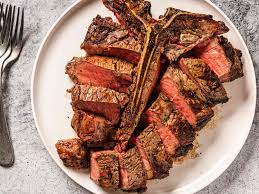May the bones be with you – and your meat!

While other chefs are staying clear of bone in cuts, this is a great opportunity for you to go for them! If you are one of the many home chefs who purchase boneless meat, you are leaving money on the table because you actually pay for the bones that were a part of the meat. The price of these boneless cuts is built into the cost of having and then removing the bones. Since there is more demand for boneless cuts this puts upward pressure on the prices which, in turn, puts downward pressure on its bone in counterparts given that the demand isn’t so great.
Now that you know that bone in meat is likely to be cheaper than boneless meat, you may still be asking – why bother with bones? Aren’t they a waste of storage and cooking space?
The short and long answer to both questions is NO. Bones are useful and here’s why:
Steak cooking (T bone, rib eye, chops and cutlets)
Throughout my book Your Meat Mate, I have always stated that the main key to good and professional steak cooking is to cook the steak slowly. That is, on a low heat and longer period (compared to high heat and shorter period of time). The reason being is that you retain more juices and flavour. Start with a high heat to brown the exterior followed by lowering the heat to gently cook the interior.
If the bone is attached (as is the case with the T bone, rib eye, chops and cutlets), then the bone acts as an insulator. This means that the meat nearest to the bone takes longer to heat up compared to the rest of the meat. This may sound inconvenient, but the slowness of heat will, as I explained in the last paragraph, cause the meat’s interior to retain more juices and flavour. Turning the meat regularly will also help to even out the cooking process – given that the rest of the steak is heating up faster than the part closest to the bone.
These bone in steaks are well priced compared to their fellow tender cuts and that’s probably because there isn’t as much of a demand for them as there is for the other cuts – because of the bone. People probably see the bone more as an inconvenience rather than what it can truly do for the dish.
Now that you know of the bone in steaks’ benefits, take advantage of it!
Braised dishes
I speak extensively in Your Meat Mate on the value of braising – especially the braising of bone in meat (for example, ribs and Osso Bucco). A braised dish, when cooking in the oven for a long period and low heat gains enormous benefit from what the bones can contribute. The connective tissue, that is naturally present in these tough and bone in cuts, breakdown and converts to gelatin that permeates the meat and the sauce resulting in a top-quality delicious dish!
Here’s what you will be sadly missing out on if you don’t eat bone in meat:
Health and nutrients
Why would you buy tablets to give you a mineral boost of calcium, sodium, magnesium, phosphorus and other important nutrients when all this is available, in its natural form in bones?
Bone marrow
Who would have thought that the soft part in the bones would be so valuable and nutritional? Well, its yours – for free! Meat itself doesn’t provide any vitamin A but the marrow does. We need vitamin A for our vision, immune system and cell health.
Another bone marrow benefit: for bone in meat where there is plenty of marrow, when heated, the marrow juices melt and permeate the meat adding a flavour that you won’t experience in boneless meat!
Summary
Today we’re all about convenience and that is why we purchase boneless meat but think of the taste and health benefits! Also, think of the cost benefits! These bone in cuts are not in high demand which means they will always be ‘ripe for the picking’!
Next time you are at the butcher, pick up a bone in cut!
For more on red meat cooking
https://www.philbysfinefoods.com.au/your-meat-mate-book/
